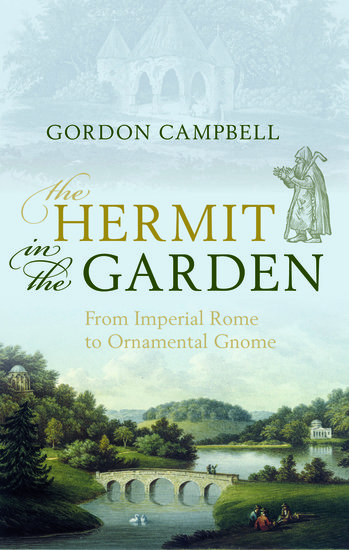By Gordon Campbell
For many years, answering polite enquiries about my current book project was relatively easy: I could explain that it was about Milton, or the Bible, or Renaissance art and architecture, or the decorative arts, or whatever might be the topic, and the conversation could happily proceed to more interesting subjects. For the past few years, however, I have had to say that I was writing a book about ornamental hermits in eighteenth-century gardens. A few – very few – interlocutors have been able to say “ah yes”, either because they were good at bluffing or because they actually knew a little about garden hermits, but most have assumed politely that I had fallen off my trolley and was descending from cultural history into incoherent mutterings.

I became interested in the subject some 40 years ago, when I chanced upon Edith Sitwell’s essay on “Ancients and Ornamental Hermits”. The idea of keeping an ornamental hermit in one’s garden was entirely new to me, and I certainly could not afford to engage one, but I did resolve to learn what I could about this phenomenon when I had time to do so. A professional career intervened, and so the idea marinated in my mind for decades before I could clear the space to undertake the requisite research. Finding the hermits and their hermitages was challenging, as ornamental hermits tend not to appear in the usual records, and hermitages are often overlooked in architectural histories. Mere facts, however, can often be uncovered by the dogged researcher. Understanding the phenomenon of the garden hermit has been a much more difficult task. At one level, ornamental hermits seem merely frivolous, but their existence hints at a complex and serious strain in Georgian culture.
Garden hermits were variously real people, automatons and wholly imagined people who had perpetually stepped out for a minute, leaving their eyeglasses and a book on the table of the hermitage. The most substantial material remains of these hermits are their hermitages, which are scattered across Britain and Ireland. At Brocklesby Park, the Lincolnshire seat of the Pelham family, the hermitage is of the type known as a root house, and what seems to be the original furniture survives inside, including a table made from a bole, a rustic hermit’s chair formed from branches, and four visitors’ chairs carved out of solid tree trunks. At Killerton, the Devonshire home of the Acland family (now National Trust), there is a luxury three-room hermitage known as the Bear’s Hut (which once accommodated a pet black bear brought from Canada); one of the rooms is the (imaginary) hermit’s chapel, which has a full-length lancet window inserted into a shaped tree trunk and fitted with Netherlandish painted glass panels.

Aspiring hermits could advertise their availability for employment. Similarly, landlords could advertise for hermits, though as Lady Croom (in Tom Stoppard’s Arcadia) comments, “surely a hermit who takes a newspaper is not a hermit in whom one can have complete confidence”. One of my favourite hermits is the Reverend Henry White, whose day job was that of rector and schoolmaster at Fyfield, near Andover (Hampshire), but whose vocation as a young man was that of hermit to his brother Gilbert White, the author of The Natural History of Selborne. Henry was, like Gilbert, a naturalist and diarist, but he also happily donned the costume of a hermit to entertain Gilbert’s guests while they munched on the cantaloupe that he grew in his garden. In the summer of 1763 Gilbert White entertained the three daughters of an eminent physician at Selborne, and Henry the Hermit was regularly in sociable attendance. When one of the sisters had to leave, Henry lamented her departure in verse:
The hoary hermit in his calm retreat,
No longer safe from her resistless charms;
With trembling hand, dim eye, and faltering feet,
Sighs out his dotage o’er her snowy arms!
Henry so enjoyed playing the part of the ornamental hermit that he had himself painted in front of the hermitage; the painting now hangs at Dunham Massey, a National Trust property in Cheshire.
The fashion for the ornamental hermit has faded, but we still have human figures in our gardens. Indeed, one of the figures had has filled the void left by the ornamental hermit is the humble garden gnome, which has for many years suffered the ignominy of exclusion from the Chelsea Flower Show (gnomes are far too working-class for Chelsea), but nonetheless embodies a quiet dignity that recalls its heroic past as a human figure in the eighteenth-century landscape garden.
Gordon Campbell is Professor of Renaissance Studies at University of Leicester. His books for OUP include Bible: The Story of the King James Version, John Milton: Life, Work and Thought, and The Grove Encyclopedia of Northern Renaissance Art. His most recent book is The Hermit in the Garden: From Imperial Rome to Ornamental Gnome.
Subscribe to the OUPblog via email or RSS.
Subscribe to only British history articles on the OUPblog via email or RSS.
Image credit: Images © Professor Gordon Campbell. Do not reproduce without permission.



[…] It was fashionable in Europe in the 16-18th centuries for well to do nobles to keep a hermit on their property, providing food and a "hermitage" in exchange for them living their, not cutting their hair, and keeping quiet. Discovering the hermit in the garden | OUPblog […]
[…] Campbell has written what has to be the most thorough and enjoyable book on the phenomenon, The Hermit in the Garden. Subtitled “From Imperial Rome to Garden Gnome,” Campbell focuses primarily on Georgian […]